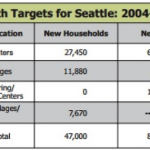Housing Prices: Will Incentives and Inclusion Help?
First of a two part series by Jerrell Whitehead. The posts here on zoning are longer versions of material he completed while at Sightline Institute. His initial interest on this subject came from conversations with A-P Hurd, Vice-President at Touchstone, who gave a number of reasons why housing construction costs are growing in Seattle. All views expressed here are his own.
On September 5th, 2014, in the somewhat quiet confines of Seattle’s City Hall, Councilmember Mike O’Brien loudly pronounced words that anyone looking for a place to rent in this city well comprehends: Seattle has a housing crisis. Seattle, now standing tall as the fastest growing major city in America, must confront the fundamental issue of where to house all these eager newcomers. Councilmember O’Brien is the chair of the Planning, Land Use, and Sustainability Committee, which last met Tuesday, September 16th, to discuss the particular incentives the city uses to encourage the production of affordable housing. On September 23rd, Mayor Ed Murray announced the creation of the Housing Affordability & Livability Advisory Committee, which is to offer recommendations by May 2015. This news makes it clear that housing affordability will be a significant and highly contentious issue in the next 12 months.
Background
Following the dark days of the recent economic downturn, Seattle now ranks alongside New York, San Francisco, and Washington D.C. as the nation’s top markets. Seattle is growing rapidly—even faster than the city envisioned in its decade-old Comprehensive Plan, which is the city’s grand strategy on how to accommodate a far larger population. The plan projected 47,000 new households (as well as 84,000 new jobs) between 2004 and 2024. Ten years into that plan, the city is well ahead of that schedule. As of 2012, there were 312,853 housing units in Seattle. Fully demonstrating that growth figures may need to be revised upwards, there were 29,330 net new housing units added from 2005 to 2012, or roughly 62 percent of the 2024 target. A rapid influx of newcomers often signals a strong economy—and Seattle has been adding jobs at a fast pace. Over March 2013-14, King County (which includes Seattle) was ranked as the fifth county nationally with the largest increases in employment level.
Seattle Comprehensive Plan by Seattle Department of Planning & Development
Seattle Comprehensive Plan by Seattle Department of Planning & Development
Yet amidst a boom in business, acute concerns persist: housing prices and rents are trending upwards in the face of rapid migration. A palpable sense is growing that Seattle is pricing out many of the citizens it once warmly welcomed. Rather than focusing on the entirety of the housing market, both the City Council and Mayor Ed Murray are paying attention to the issue of affordable housing for lower income groups. There is the pervading belief that rents are simply too high and that the best recourse is stronger government intervention. Slowly, and ever louder, the public is starting to clamor for its representatives to do something, anything, which will bring results on this essential issue.
Presently, existing housing incentives for private developers are set to undergo major changes, and a forthcoming series of posts seeks to better inform that debate. Two policy measures are at the heart of Seattle’s development incentive scheme: incentive zoning and the multi-family tax exemption program (MFTE). The latter will be discussed in a future post, but here the focus is on broad analysis of incentive zoning.
Definitions
Incentive zoning is the progeny of inclusionary zoning, and the ultimate purpose of both is to make the creation of affordable housing a key part of a community’s new development. Today, inclusionary or incentive zoning programs come in all shapes and sizes. Some offer developers incentives to build low-rent units. Others require developers to include below-market units in every new housing development. Some give developers a choice between building new units and paying into a municipal housing fund dedicated to building low-rent units. Inclusionary zoning programs differ in the types of development covered, the share of new units required, the required price for new rental units, who can obtain low-cost units, and the length of time that “affordable” units must be offered at below-market rates. Many of these zoning programs mandate that units offered at below-market rates be of similar size and quality as the market-price units, and also spread throughout the project to avoid creating conspicuous public housing or “projects”. However, New York City developers recently have generated national opprobrium by offering affordable units accessible only through “poor doors” separated from main entrances for market-rate units.
Zoning: A VERY Brief History
Zoning of any kind is a relatively new practice in the United States. The nation’s first zoning codes originated in New York City in 1916, spurred by new high-rises opposed by neighbors. The use of zoning quickly spread to other municipalities. In 1926 the United States Supreme Court upheld the practice of zoning, ruling that the zoning laws of Euclid, Ohio passed constitutional muster.
Many (but not all) of these early zoning programs were both racist and classist, as they were principally created to keep “undesirable” people away from higher-income neighborhoods. This was accomplished by restricting both the types of housing that builders could build, and by restricting the kinds of people who could live in them. Over time, municipalities used zoning to reserve large swaths of their total land area for single family houses with ample yards—a particularly expensive form of housing, and one that limited the number of lower-income folks who could afford to live near the well-off.
As a reaction to this sort of “exclusionary” zoning, in the early 1970s US municipalities began to adopt “inclusionary” zoning policies designed to ensure that developers provide low-cost housing to at least some residents. The first inclusionary zoning policy, passed in Fairfax County, Virginia in 1971, mandated that developers of more than 50 units of multi-family housing provide 15 percent of their units at prices that were affordable to residents within 60 to 80 percent of median income. In 1973, the Virginia Supreme Court overturned the ordinance, asserting that it was a “taking” of property rights without fair compensation. (See Fairfax County v. Degroff) Nonetheless, in 1973 nearby Montgomery County, Maryland, passed a “moderately priced dwelling unit” ordinance, which required developers of more than 50 residential units to set aside 12.5 to 15 percent of total units, dispersed throughout the property and available to families with 50 to 80% of the area median income. It is still active as of 2014.
The Montgomery County, Maryland ordinance is the oldest in America. But California, with over one hundred ordinances and 30 years of experience, has the most familiarity with inclusionary zoning. The Bay Area standard bearer is Palo Alto, which first instituted their program in 1973. Today, more than 100 communities in California have similar zoning statutes. Nationally, the ordinances can be found in Colorado, New Jersey, and Oregon, amongst other states.
Controversy
In whatever guise — voluntary or mandatory; with incentives or none at all — the use of inclusionary zoning schemes to procure affordable housing is deeply controversial. Municipal governments love these ordinances because affordable housing units are made, and for-profit developers are forced to pay their fair share. Next, eligible residents lucky enough to live in one of the new units receive a place to call home at a below-market price. Conversely, developers, economists, and pro-growth activists see inclusionary zoning as a straightforward tax on development that adds to construction costs and stunts supply. As total construction falls, the price of market-rate housing increases, and the whole housing market is grossly distorted.
Next in this series, we discuss the argument of each opposing side in this contentious debate.
Jerrell Whitehead is a former Research Fellow of the Sightline Institute. He is a Bill & Melinda Gates Scholar, and earned his Master’s (MPhil) and PhD in economic and social history from the University of Cambridge. Thanks for research assistance must be extended to A-P Hurd of Touchstone Corporation, Kayla Schott-Bresler of the Housing Development Consortium, and Esther Handy, legislative aide to Seattle City Councilmember Mike O’Brien.




